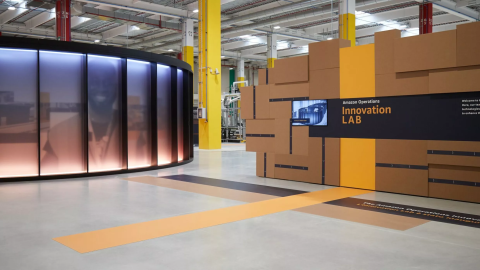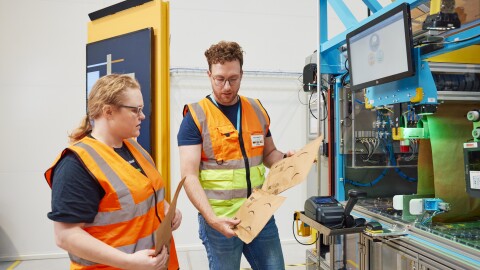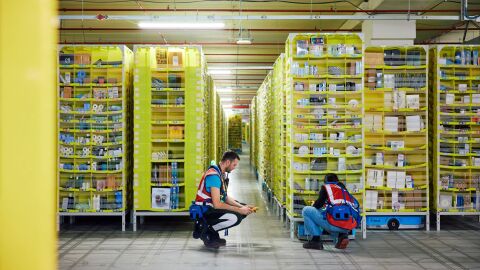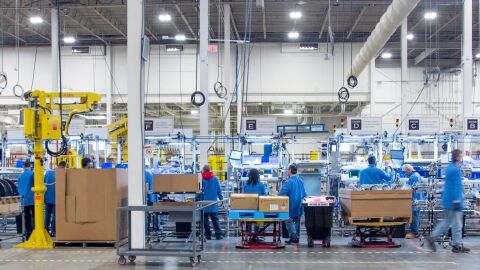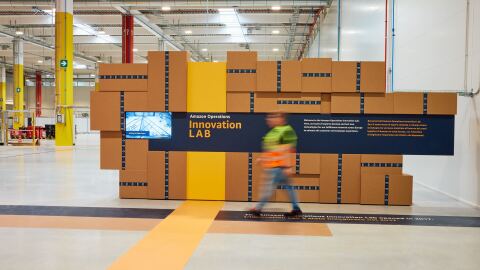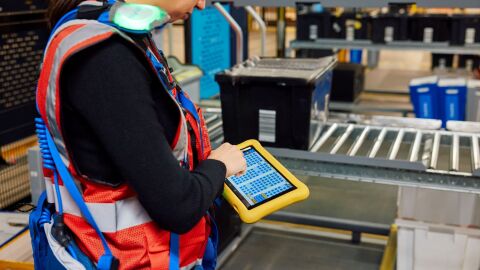It has been almost two decades since Andy Jassy and his team of technologists saw the immense potential in sharing the innovative technology behind Amazon.com with other companies, and proposed selling it as a service to help them transform their businesses, bringing Amazon Web Services (AWS) to life. Today, the highly scalable, reliable IT infrastructure unlocks benefits for millions of customers across the globe, using AI, machine learning, data analytics, and the internet of things (IoT) to deliver wide-reaching, sometimes revolutionary, change to countless industries.
Each industry faces a unique set of challenges, and over the years, the team at AWS has spotted the need to offer purpose-built cloud services to help specific industries tackle these head-on. Logistics is one such area, where AWS solutions have torn up the rulebook to improve efficiency, enhance safety, and deliver for customers faster.
In this article, we explore three technologies that have radically optimised Amazon’s operations and discover how AWS innovation sits at the heart of each one. This includes Amazon Monitron, Amazon SageMaker, and a practical application of remote control and monitoring technologies exemplified by the Automated Tote Retriever – an Amazon technology seamlessly uploaded to the cloud and fully operated through remote control.
Alessandra Antonelli, Country Manager for Amazon Web Services, Italy, said: “Cloud computing has been transformative in the logistics industry, and together with AI, machine learning, and the smart sensors found in the internet of things (IoT), has been nothing short of revolutionary in the way the fulfilment sector operates. Our vision for the future reflects this positive progress; a world where advanced solutions continue, step by step, to make work safer and more efficient for everyone.”
Reducing downtime and improving the employee and customer experience
Amazon Monitron an end-to-end condition monitoring system, uses IT, data analytics, and machine learning algorithms to predict equipment failures early. This system delivers a big impact, with its tiny sensors on a motor, pump, or conveyor belt in Amazon’s fulfilment centres (FCs). It collects data and sends it to the cloud, where an algorithm can detect anomalies and alert engineers almost instantaneously and allows for predictive maintenance on a scale never imagined.
Amazon’s FCs operate 24/7 during peak periods, to meet delivery promises to customers. This means even the smallest of disruptions can delay deliveries. This is where advanced technologies like Amazon Monitron play an essential role in enhancing operations. Since rolling out the technology in 2021, unplanned downtime has reduced by 69%, supporting Amazon in delivering on its promise to customers.
Right now, 104,000 Amazon Monitron sensors are in operation across Amazon’s FCs in Europe, monitoring more than 34,000 pieces of technology across 192 sites. These ensure Amazon’s operations are as efficient as possible, every day. It has also unlocked further efficiencies at an operational level, saving an estimated $37.83 million.
Beyond improving the fulfilment process, the roll-out of Amazon Monitron across Amazon’s FCs is positively benefitting the teams that work there, too. Previously, technicians used to walk long distances to monitor equipment. But now, the sensors automatically trigger pre-emptive repairs. These are logged on a central dashboard, where technicians can quickly detect anomalies earlier. It improves the employee experience, while also enabling Amazon to deliver for consumers – the ultimate win-win.
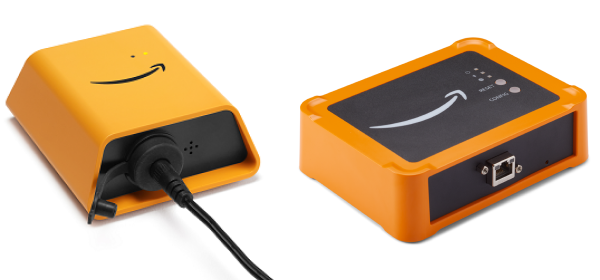
Achieving operational efficiencies through the power of machine learning and AI
Amazon SageMaker is an incredibly versatile platform, enabling data scientists and developers to build and deploy machine learning and AI models at any scale, easily and quickly. It optimises operations across storage, picking, demand forecasting, and mapping across Amazon’s FCs worldwide.
It plays a key role in the journey of products into and out of Amazon’s network. As soon as a shipment arrives, an automated storage system, powered by Amazon SageMaker, identifies the optimal place to store the items, so picking is more efficient. It forecasts core demand, meaning products can be intelligently stocked and positioned at core FCs. It also ensures warehouse layouts and robot fleets are optimised, using data to boost productivity.
Once customer deliveries have left an FC, Amazon SageMaker optimises delivery routes and driving patterns, reducing costs, shortening delivery times, and making the last mile more sustainable than previously possible. In many ways, it is the cornerstone of Amazon’s fulfilment and logistics network, enabling faster deliveries, lower costs, and an improved customer experience.
Remote control and monitoring fulfilment technology through the cloud
Another good example of the practical applications of AWS services is in the remote control and monitoring of the Automated Tote Retriever (ATR). This mechatronic system is designed to automate the retrieval and transport of tote bins containing products in Amazon’s FCs.
A moving shuttle is alerted when a tote is full of products and uses a special gripper to replace the full tote with an empty one. This entirely automated process removes the need for Amazon employees to manually lift these totes, improving safety, ergonomics, and efficiency. The AWS cloud allows these technologies to be monitored entirely remotely across the globe, with highly connected systems that deliver complete visibility, allowing for immediate intervention, if necessary.
AWS is the backbone that delivers better fulfilment
Cloud computing and AWS are part of Amazon’s DNA, and the technologies running on AWS today power the company’s entire operational network. These intelligent yet complex systems are designed from the ground up to optimise the fulfilment process and are ultimately what enable Amazon to deliver on its promises to customers.
But the benefits to society are so much greater. Solutions like Amazon Monitron, Amazon SageMaker, and ATR are the first of many that will propel the logistics sector forward, and AWS is as committed as ever to be the one leading that change.
To learn more about Amazon Web Services, click here.





